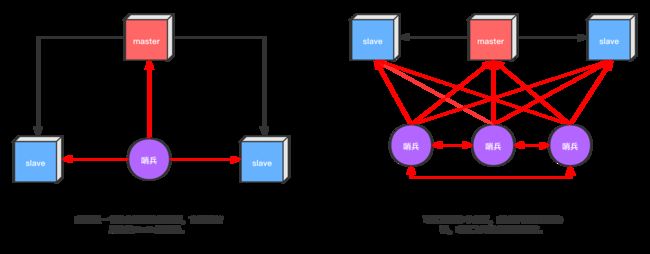- Java大厂面试实录:谢飞机的电商场景技术问答(Spring Cloud、MyBatis、Redis、Kafka、AI等)
Java大厂面试实录:谢飞机的电商场景技术问答(SpringCloud、MyBatis、Redis、Kafka、AI等)本文模拟知名互联网大厂Java后端岗位面试流程,以电商业务为主线,由严肃面试官与“水货”程序员谢飞机展开有趣的对话,涵盖SpringCloud、MyBatis、Redis、Kafka、SpringSecurity、AI等热门技术栈,并附详细解析,助力求职者备战大厂面试。故事设定谢
- Java大厂面试故事:谢飞机的互联网音视频场景技术面试全纪录(Spring Boot、MyBatis、Kafka、Redis、AI等)
来旺
Java场景面试宝典JavaSpringBootMyBatisKafkaRedis微服务AI
Java大厂面试故事:谢飞机的互联网音视频场景技术面试全纪录(SpringBoot、MyBatis、Kafka、Redis、AI等)互联网大厂技术面试不仅考察技术深度,更注重业务场景与系统设计能力。本篇以严肃面试官与“水货”程序员谢飞机的对话,带你体验音视频业务场景下的Java面试全过程,涵盖主流技术栈,并附详细答案解析,助你面试无忧。故事场景设定谢飞机是一名有趣但技术基础略显薄弱的程序员,这次应
- Redis Sentinel(哨兵) 和 Redis Cluster(集群)
G丶AEOM
八股普通学习区Redisredis数据库缓存
哨兵机制和集群有什么区别Redis集群主要有两种,一种是RedisSentinel哨兵集群,一种是RedisCluster。主从集群,包括一个Master和多个Slave节点,Master负责数据的读写,Slave负责数据的读取,Master上收到的数据变更会同步到Slave节点上实现数据同步,但不提供容错和恢复,在Master宕机时不会选出新的Master,导致后续客户端所有写请求直接失败。所以
- php SPOF
贵哥的编程之路(热爱分享 为后来者)
PHP语言经典程序100题php开发语言
1.什么是单点故障(SPOF)?单点故障指的是系统中某个组件一旦失效,整个系统或服务就会不可用。常见的单点有:数据库、缓存、Web服务器、负载均衡、网络设备等。2.常见单点故障场景只有一台数据库服务器,宕机后所有业务不可用只有一台Redis缓存,挂掉后缓存全部失效只有一台Web服务器,挂掉后网站无法访问只有一个负载均衡节点,挂掉后流量无法分发只有一条网络链路,断开后所有服务失联3.消除单点故障的主
- php 高并发下日志量巨大,如何高效采集、存储、分析
贵哥的编程之路(热爱分享 为后来者)
PHP语言经典程序100题php开发语言
1.问题背景高并发系统每秒产生大量日志(如访问日志、错误日志、业务日志等)。单机写入、存储、分析能力有限,容易成为瓶颈。需要支持实时采集、分布式存储、快速检索与分析。2.主流架构方案一、分布式日志采集架构[应用服务器(PHP等)]|v[日志采集Agent(如Filebeat、Fluentd、Logstash)]|v[消息队列/缓冲(如Kafka、Redis、RabbitMQ)]|v[日志存储(如E
- redis集群之Sentinel哨兵高可用
会飞的爱迪生
redisredissentinelbootstrap
Sentinel是官网推荐的高可用(HA)解决方案,可以实现redis的高可用,即主挂了从代替主工作,在一台单独的服务器上运行多个sentinel,去监控其他服务器上的redismaster-slave状态(可以监控多个master-slave),当发现master宕机后sentinel会在slave中选举并启动新的master。至少需要3台redis才能建立起基于哨兵的reids集群。一、通过s
- redis管道 -redis pipeline -redis pipelining
shuair
redisredisbootstrap数据库
redis管道文档redis单机安装redis常用的五种数据类型redis数据类型-位图bitmapredis数据类型-基数统计HyperLogLogredis数据类型-地理空间GEOredis数据类型-流Streamredis数据类型-位域bitfieldredis持久化-RDBredis持久化-AOFredis持久化-RDB+AOF混合模式redis事务官方文档官网操作命令指南页面:https
- redis中什么是bigkey?会有什么影响?
Vic2334
redis
什么是bigkey?会有什么影响?bigkey是指key对应的value所占的内存空间比较大,例如一个字符串类型的value可以最大存到512MB,一个列表类型的value最多可以存储23-1个元素。如果按照数据结构来细分的话,一般分为字符串类型bigkey和非字符串类型bigkey。字符串类型:体现在单个value值很大,一般认为超过10KB就是bigkey,但这个值和具体的OPS相关。非字符串
- 如何发现 Redis 中的 BigKey?
sevevty-seven
redisbootstrap数据库
如何发现Redis中的BigKey?Redis因其出色的性能,常被用作缓存、消息队列和会话存储。然而,在Redis的使用过程中,BigKey是一个不容忽视的问题。BigKey指的是存储了大量数据或包含大量成员的键。它们不仅会占用大量内存,还可能导致网络延迟、主从同步延迟,甚至在极端情况下引发Redis服务崩溃。因此,有效地发现和处理BigKey对于维护Redis服务的稳定性和性能至关重要。本文将深
- Java实习模拟面试之安徽九德 —— 面向对象编程、Spring框架与数据库技术详解
培风图南以星河揽胜
java面试java面试spring
关键词:Java实习生、模拟面试、安徽九德、SpringBoot、MySQL、Redis、面向对象编程、团队协作一、前言作为一名计算机相关专业的学生,想要顺利进入一家互联网公司或软件开发企业实习,技术面试是必须面对的一道门槛。本文将带你走进一场真实的Java实习生模拟面试场景,以“安徽九德”公司为背景,围绕其发布的招聘岗位要求,进行一次全方位的技术面试演练。本次模拟面试涵盖以下核心知识点:Java
- Docker初识:mysql8主从复制(单向)- 主从搭建扩展知识
滴水可藏海
#mysql数据库
主从服务(master-slave)新学习到的知识。1、全库同步与部分同步上回书说到Docker初识:mysql8主从复制(单向)的配置都是针对全库配置的。但是实际上并不需要针对全库做备份,只需要对一些特别重要的库或者表来进行同步。例如information_schema等。可以通过配置文件中的一些属性指定需要针对哪些库或者哪些表记录binlog。Master配置:#需要同步的二进制数据库名bin
- Redis第五讲:详解 Redis 中 BigKey、HotKey 的发现与处理
程序员 jet_qi
深入理解数据库redis数据库缓存大key热点key
简介:在Redis的使用过程中,我们经常会遇到BigKey(下文将其称为“大key”)及HotKey(下文将其称为“热key”)。大Key与热Key如果未能及时发现并进行处理,很可能会使服务性能下降、用户体验变差,甚至引发大面积故障。本文详解Redis中BigKey、HotKey的发现与处理。文章目录1、大Key与热Key的定义1.1、什么是大Key1.2、什么是热Key2、大Key与热Key带来
- redission 实现滑动窗口(注解)推荐
结构目录相关代码org.redissonredisson-spring-boot-starter3.17.0packageorg.example.redission.config;importorg.redisson.Redisson;importorg.redisson.api.RedissonClient;importorg.redisson.config.Config;importorg.s
- 如何发现Redis中的bigkey?
代码中の快捷键
redis数据库缓存
如何发现Redis中的bigkey?我主要用这几个方法:redis-cli--bigkeys(最常用,最省事):直接在命令行敲这个命令:redis-cli-h你的redis地址-p端口--bigkeys作用:它会自动扫描整个数据库。结果:告诉你每种数据类型(String,Hash,List,Set,ZSet)里最大的那个key是什么,有多大(比如String多大,List有多少元素)。优点:简单、
- Redis简介之它是啥
财神爷首席大弟子
Redisredis数据库缓存
什么是RedisRedis是一个基于BSD协议的开源数据库,是一个以键值对形式的存储系统Redis常用于消息队列,缓存,会话存储等场景Redis是使用C语言编写使用许可证:BSD许可证是一个开源的宽松的软件许可协议Redis优点性能极高Redis是以高性能著称,可全天24小时达到每秒十万次的读写操作数据类型丰富哈希字符串集合列表有序集合原子性操作原子性操作是指,程序要么不执行,要嘛执行完毕,这种对
- Windows下的redis
517
redis数据库缓存
1:在配置path后:redis-cli默认16个数据库2然后再验证set和get命令,如果一切正常便安装部署成功。一、键(Key)的增删改查操作命令示例说明增SETkeyvalueSETusername"john"设置字符串键值删DELkeyDELusername删除键(可多键:DELk1k2)改SETkeynew_valueSETusername"mike"覆盖原有值查GETke
- redis基础(1)
在Redis中,设置键值并同时指定以秒为单位的过期时间,有以下两种常用方式:方法1:使用SET命令+EX选项(推荐)SETkeyvalueEXseconds说明:在设置键值对的同时直接指定过期时间(秒)SETuser:token"abc123"EX3600#设置token并设置1小时后过期(3600秒)方法2:使用SETEX命令SETEXkeysecondsvalue说明:专用于设置带过期时间的字
- redis锁java实现
brave_zhao
redisjava数据库
以下是几种常见的Redis分布式锁的Java实现方式:1.基于SETNX命令的实现SETNX命令(对应Java中的setIfAbsent方法)是实现Redis分布式锁的基础。以下是实现代码:importredis.clients.jedis.Jedis;publicclassRedisLock{privateJedisjedis;publicRedisLock(Jedisjedis){this.j
- 从面试懵逼到通透掌握:分布式锁原理全解(附Redisson与Redlock机制剖析)
爱骑行的Coder
数据库redisjava基础面试分布式javaredis后端
从面试懵逼到通透掌握:分布式锁原理全解(附Redisson与Redlock机制剖)你是不是也有这样的经历?简历上写着“精通Java,精通Redis,熟悉高并发场景”,结果一面下来,分布式锁怎么实现?Redisson是怎么加锁的?看门狗机制了解吗?锁丢失你知道怎么解决吗?全程“啊能能”,频频磕巴。本文不整虚的,带你从0到1,一步步真正搞懂分布式锁的原理与落地实践,面试高频,架构核心,不能不会。一、什
- 主从复制原理
1.主从复制是什么?主从复制是数据库实现高可用,读写分离,备份的核心功能。其核心原理是:主库日志的事件同步到从库中,并重新执行操作,最终从库与主库一致。2.主从复制原理2.1主库执行写(增删改)操作之后,会将操作记录写入二进制日志(binlog)中,binlog会存放所有变更数据的详细记录。2.2从库启动I/O线程,连接主库并请求读取binlog。主库启动dump线程,将binlog中新的事件(从
- Spring Boot使用Redis常用场景
蹦跑的蜗牛
springbootredis后端
SpringBoot使用Redis常用场景一、概述:Redis是什么?为什么要用它?Redis(RemoteDictionaryServer)是一个内存中的数据存储系统(类似一个“超级大字典”),它能存各种类型的数据(字符串、列表、哈希等),而且读写速度极快(因为数据存在内存里)。简单说,Redis就像电脑的“缓存抽屉”:当你的程序需要频繁读取或修改某些数据时(比如用户登录信息、商品销量),直接从
- 使用 Docker 搭建 Python(Flask/CUDA AI)开发环境——AI教你学Docker
使用Docker搭建Python(Flask/CUDAAI)开发环境及常用中间件配置详解本指南适用于用Docker快速搭建Python(FlaskWeb应用或包含CUDA的AI开发环境)开发环境,并集成常用中间件服务如MySQL、Redis、Kafka。适合个人开发、本地测试和小团队协作。一、项目目录结构建议project-root/├──app/#Python应用源码目录│├──Dockerfi
- Redis 性能优化实战:管道、事务、缓存与连接管理全解析
佑瞻
数据库与知识图谱缓存redis性能优化
在日常开发中,我们常常会遇到Redis操作的性能瓶颈:频繁的命令交互导致网络开销激增,并发更新时的数据一致性难以保证,海量数据遍历引发的阻塞问题……其实,Redis早已为这些场景准备了“利器”。今天我们就深入探讨Redis的管道、事务、扫描迭代、客户端缓存以及连接管理技巧,用实战代码带你玩转性能优化。一、管道(Pipelines):批量执行命令,减少网络往返当我们需要连续执行多个Redis命令时,
- Redis OM for Python 实战:用 Flask 构建 Redis 文档型 API
在日常开发中,我们使用Redis时常常会遇到这样的场景:需要存储复杂的结构化数据(比如用户信息、商品详情),还要支持灵活的查询(按年龄筛选、按技能搜索)。直接用Redis的基础命令处理JSON数据不仅繁琐,查询起来更是头疼。而RedisOMforPython的出现,正好解决了这些问题——它让我们能用Python类轻松建模,用简洁的代码实现CRUD和复杂查询。今天我们就结合Flask框架,手把手教你
- Mysql:分库分表
爱吃汉堡的Saul.
数据库mysql数据库
引言:随着互联网业务的飞速发展,数据量与并发请求呈现爆炸式增长。传统的单机数据库架构,即使经过垂直扩展(如提升硬件配置、优化SQL、引入读写分离),也终将面临性能瓶颈。主要挑战体现在:单表性能极限:当单表数据行数达到千万乃至亿级时,B+树索引深度增加,导致查询效率显著下降。此外,DDL(数据定义语言)操作如添加索引、修改表结构等,可能耗时数小时并长时间锁定表,严重影响业务可用性。单库资源瓶颈:单个
- redis mysql主从分离_Redis(5)-----初识Redis-----主从复制.读写分离,主从切换(哨兵机制)(示例代码)...
算法艺术家
redismysql主从分离
当数据量变得庞大的时候,读写分离还是很有必要的。同时避免一个redis服务宕机,导致应用宕机的情况,我们启用sentinel(哨兵)服务,实现主从切换的功能。https://www.cnblogs.com/jaycekon/p/6237562.html一,主从分离(读写分离,主从复制)首先我们默认已经安装了redis,然后复制master,slave1,slave2三个redis的文件。并把red
- 【网络与爬虫 24】爬虫数据存储方案:从文件到数据库的全面指南
莫比乌斯@卷
技术技巧#网络与爬虫网络爬虫数据库
【网络与爬虫24】爬虫数据存储方案:从文件到数据库的全面指南关键词:爬虫数据存储、CSV、JSON、Excel、SQLite、MySQL、MongoDB、Redis、数据持久化、数据管理摘要:本文全面介绍爬虫数据存储的各种方案,从简单的文本文件、CSV、JSON到Excel表格,再到SQLite、MySQL等关系型数据库,以及MongoDB、Redis等NoSQL数据库。通过对比分析不同存储方式的
- 深入Redis:核心的缓存
Redis最主要的用途,主要有三个方面:存储数据、缓存、消息队列。其中,缓存是Redis最常用的场景。Redis使用内存作为硬盘的缓存。把用户集中访问的20%数据放到缓存中去,可以应对80%的请求。数据库是非常重要的组件,但是mysql的速度又比较慢,所以我们用Redis来作为mysql的缓存。为什么说关系型数据库性能不高?数据库把数据存储在硬盘上,硬盘的IO速度并不快。尤其是随机访问。如果查询不
- Spring RedisTemplate中文乱码
NO爷
JavaSpringBootRedisJedis乱码
Redis客户端中文乱码网上非常常见的乱码,百度一搜大部分都是这种情况。如果不是此种情况请看下一节。redis-cliredis127.0.0.1:6379>set'name''中文'OKredis127.0.0.1:6379>get'name'"\xd6\xd0\xce\xc4"redis127.0.0.1:6379>客户端查看乱码,这个情况我们只要将修改客户端命令行就可以。redis-cli-
- 掌握 Spring Data Redis,提升后端开发效率
掌握SpringDataRedis,提升后端开发效率关键词:SpringDataRedis、后端开发、缓存、数据持久化、效率提升摘要:本文旨在深入探讨SpringDataRedis这一强大的工具,帮助后端开发者更好地掌握它以提升开发效率。首先介绍SpringDataRedis的背景知识,包括其目的、适用读者等。接着详细阐述核心概念与联系,分析核心算法原理并给出具体操作步骤,通过数学模型和公式加深理
- 矩阵求逆(JAVA)初等行变换
qiuwanchi
矩阵求逆(JAVA)
package gaodai.matrix;
import gaodai.determinant.DeterminantCalculation;
import java.util.ArrayList;
import java.util.List;
import java.util.Scanner;
/**
* 矩阵求逆(初等行变换)
* @author 邱万迟
*
- JDK timer
antlove
javajdkschedulecodetimer
1.java.util.Timer.schedule(TimerTask task, long delay):多长时间(毫秒)后执行任务
2.java.util.Timer.schedule(TimerTask task, Date time):设定某个时间执行任务
3.java.util.Timer.schedule(TimerTask task, long delay,longperiod
- JVM调优总结 -Xms -Xmx -Xmn -Xss
coder_xpf
jvm应用服务器
堆大小设置JVM 中最大堆大小有三方面限制:相关操作系统的数据模型(32-bt还是64-bit)限制;系统的可用虚拟内存限制;系统的可用物理内存限制。32位系统下,一般限制在1.5G~2G;64为操作系统对内存无限制。我在Windows Server 2003 系统,3.5G物理内存,JDK5.0下测试,最大可设置为1478m。
典型设置:
java -Xmx
- JDBC连接数据库
Array_06
jdbc
package Util;
import java.sql.Connection;
import java.sql.DriverManager;
import java.sql.ResultSet;
import java.sql.SQLException;
import java.sql.Statement;
public class JDBCUtil {
//完
- Unsupported major.minor version 51.0(jdk版本错误)
oloz
java
java.lang.UnsupportedClassVersionError: cn/support/cache/CacheType : Unsupported major.minor version 51.0 (unable to load class cn.support.cache.CacheType)
at org.apache.catalina.loader.WebappClassL
- 用多个线程处理1个List集合
362217990
多线程threadlist集合
昨天发了一个提问,启动5个线程将一个List中的内容,然后将5个线程的内容拼接起来,由于时间比较急迫,自己就写了一个Demo,希望对菜鸟有参考意义。。
import java.util.ArrayList;
import java.util.List;
import java.util.concurrent.CountDownLatch;
public c
- JSP简单访问数据库
香水浓
sqlmysqljsp
学习使用javaBean,代码很烂,仅为留个脚印
public class DBHelper {
private String driverName;
private String url;
private String user;
private String password;
private Connection connection;
privat
- Flex4中使用组件添加柱状图、饼状图等图表
AdyZhang
Flex
1.添加一个最简单的柱状图
? 1 2 3 4 5 6 7 8 9 10 11 12 13 14 15 16 17 18 19 20 21 22 23 24 25 26 27 28
<?xml version=
"1.0"&n
- Android 5.0 - ProgressBar 进度条无法展示到按钮的前面
aijuans
android
在低于SDK < 21 的版本中,ProgressBar 可以展示到按钮前面,并且为之在按钮的中间,但是切换到android 5.0后进度条ProgressBar 展示顺序变化了,按钮再前面,ProgressBar 在后面了我的xml配置文件如下:
[html]
view plain
copy
<RelativeLa
- 查询汇总的sql
baalwolf
sql
select list.listname, list.createtime,listcount from dream_list as list , (select listid,count(listid) as listcount from dream_list_user group by listid order by count(
- Linux du命令和df命令区别
BigBird2012
linux
1,两者区别
du,disk usage,是通过搜索文件来计算每个文件的大小然后累加,du能看到的文件只是一些当前存在的,没有被删除的。他计算的大小就是当前他认为存在的所有文件大小的累加和。
- AngularJS中的$apply,用还是不用?
bijian1013
JavaScriptAngularJS$apply
在AngularJS开发中,何时应该调用$scope.$apply(),何时不应该调用。下面我们透彻地解释这个问题。
但是首先,让我们把$apply转换成一种简化的形式。
scope.$apply就像一个懒惰的工人。它需要按照命
- [Zookeeper学习笔记十]Zookeeper源代码分析之ClientCnxn数据序列化和反序列化
bit1129
zookeeper
ClientCnxn是Zookeeper客户端和Zookeeper服务器端进行通信和事件通知处理的主要类,它内部包含两个类,1. SendThread 2. EventThread, SendThread负责客户端和服务器端的数据通信,也包括事件信息的传输,EventThread主要在客户端回调注册的Watchers进行通知处理
ClientCnxn构造方法
&
- 【Java命令一】jmap
bit1129
Java命令
jmap命令的用法:
[hadoop@hadoop sbin]$ jmap
Usage:
jmap [option] <pid>
(to connect to running process)
jmap [option] <executable <core>
(to connect to a
- Apache 服务器安全防护及实战
ronin47
此文转自IBM.
Apache 服务简介
Web 服务器也称为 WWW 服务器或 HTTP 服务器 (HTTP Server),它是 Internet 上最常见也是使用最频繁的服务器之一,Web 服务器能够为用户提供网页浏览、论坛访问等等服务。
由于用户在通过 Web 浏览器访问信息资源的过程中,无须再关心一些技术性的细节,而且界面非常友好,因而 Web 在 Internet 上一推出就得到
- unity 3d实例化位置出现布置?
brotherlamp
unity教程unityunity资料unity视频unity自学
问:unity 3d实例化位置出现布置?
答:实例化的同时就可以指定被实例化的物体的位置,即 position
Instantiate (original : Object, position : Vector3, rotation : Quaternion) : Object
这样你不需要再用Transform.Position了,
如果你省略了第二个参数(
- 《重构,改善现有代码的设计》第八章 Duplicate Observed Data
bylijinnan
java重构
import java.awt.Color;
import java.awt.Container;
import java.awt.FlowLayout;
import java.awt.Label;
import java.awt.TextField;
import java.awt.event.FocusAdapter;
import java.awt.event.FocusE
- struts2更改struts.xml配置目录
chiangfai
struts.xml
struts2默认是读取classes目录下的配置文件,要更改配置文件目录,比如放在WEB-INF下,路径应该写成../struts.xml(非/WEB-INF/struts.xml)
web.xml文件修改如下:
<filter>
<filter-name>struts2</filter-name>
<filter-class&g
- redis做缓存时的一点优化
chenchao051
redishadooppipeline
最近集群上有个job,其中需要短时间内频繁访问缓存,大概7亿多次。我这边的缓存是使用redis来做的,问题就来了。
首先,redis中存的是普通kv,没有考虑使用hash等解结构,那么以为着这个job需要访问7亿多次redis,导致效率低,且出现很多redi
- mysql导出数据不输出标题行
daizj
mysql数据导出去掉第一行去掉标题
当想使用数据库中的某些数据,想将其导入到文件中,而想去掉第一行的标题是可以加上-N参数
如通过下面命令导出数据:
mysql -uuserName -ppasswd -hhost -Pport -Ddatabase -e " select * from tableName" > exportResult.txt
结果为:
studentid
- phpexcel导出excel表简单入门示例
dcj3sjt126com
PHPExcelphpexcel
先下载PHPEXCEL类文件,放在class目录下面,然后新建一个index.php文件,内容如下
<?php
error_reporting(E_ALL);
ini_set('display_errors', TRUE);
ini_set('display_startup_errors', TRUE);
if (PHP_SAPI == 'cli')
die('
- 爱情格言
dcj3sjt126com
格言
1) I love you not because of who you are, but because of who I am when I am with you. 我爱你,不是因为你是一个怎样的人,而是因为我喜欢与你在一起时的感觉。 2) No man or woman is worth your tears, and the one who is, won‘t
- 转 Activity 详解——Activity文档翻译
e200702084
androidUIsqlite配置管理网络应用
activity 展现在用户面前的经常是全屏窗口,你也可以将 activity 作为浮动窗口来使用(使用设置了 windowIsFloating 的主题),或者嵌入到其他的 activity (使用 ActivityGroup )中。 当用户离开 activity 时你可以在 onPause() 进行相应的操作 。更重要的是,用户做的任何改变都应该在该点上提交 ( 经常提交到 ContentPro
- win7安装MongoDB服务
geeksun
mongodb
1. 下载MongoDB的windows版本:mongodb-win32-x86_64-2008plus-ssl-3.0.4.zip,Linux版本也在这里下载,下载地址: http://www.mongodb.org/downloads
2. 解压MongoDB在D:\server\mongodb, 在D:\server\mongodb下创建d
- Javascript魔法方法:__defineGetter__,__defineSetter__
hongtoushizi
js
转载自: http://www.blackglory.me/javascript-magic-method-definegetter-definesetter/
在javascript的类中,可以用defineGetter和defineSetter_控制成员变量的Get和Set行为
例如,在一个图书类中,我们自动为Book加上书名符号:
function Book(name){
- 错误的日期格式可能导致走nginx proxy cache时不能进行304响应
jinnianshilongnian
cache
昨天在整合某些系统的nginx配置时,出现了当使用nginx cache时无法返回304响应的情况,出问题的响应头: Content-Type:text/html; charset=gb2312 Date:Mon, 05 Jan 2015 01:58:05 GMT Expires:Mon , 05 Jan 15 02:03:00 GMT Last-Modified:Mon, 05
- 数据源架构模式之行数据入口
home198979
PHP架构行数据入口
注:看不懂的请勿踩,此文章非针对java,java爱好者可直接略过。
一、概念
行数据入口(Row Data Gateway):充当数据源中单条记录入口的对象,每行一个实例。
二、简单实现行数据入口
为了方便理解,还是先简单实现:
<?php
/**
* 行数据入口类
*/
class OrderGateway {
/*定义元数
- Linux各个目录的作用及内容
pda158
linux脚本
1)根目录“/” 根目录位于目录结构的最顶层,用斜线(/)表示,类似于
Windows
操作系统的“C:\“,包含Fedora操作系统中所有的目录和文件。 2)/bin /bin 目录又称为二进制目录,包含了那些供系统管理员和普通用户使用的重要
linux命令的二进制映像。该目录存放的内容包括各种可执行文件,还有某些可执行文件的符号连接。常用的命令有:cp、d
- ubuntu12.04上编译openjdk7
ol_beta
HotSpotjvmjdkOpenJDK
获取源码
从openjdk代码仓库获取(比较慢)
安装mercurial Mercurial是一个版本管理工具。 sudo apt-get install mercurial
将以下内容添加到$HOME/.hgrc文件中,如果没有则自己创建一个: [extensions] forest=/home/lichengwu/hgforest-crew/forest.py fe
- 将数据库字段转换成设计文档所需的字段
vipbooks
设计模式工作正则表达式
哈哈,出差这么久终于回来了,回家的感觉真好!
PowerDesigner的物理数据库一出来,设计文档中要改的字段就多得不计其数,如果要把PowerDesigner中的字段一个个Copy到设计文档中,那将会是一件非常痛苦的事情。
